With the recent passing of Joe Barbera, we have now lost both of the giants responsible for the Hanna-Barbera cartoon studio. These two men had amazing success in both theatrical and television production, and it is wonderful that so much of their work is coming to be available again on DVD. Whether you are a long-time H-B fan, or a younger fan who would like to find out more about these titans of the industry, we hope you will enjoy this retrospective. Part One can be read here; what follows is the second of a three-part article.
It was not going to be easy. Conventional wisdom at the time was that a half-hour of original animation was too costly to do for television. Bill Hanna and Joe Barbera had just been fired by MGM; but after the initial shock, as far as they were concerned, the future never looked brighter.
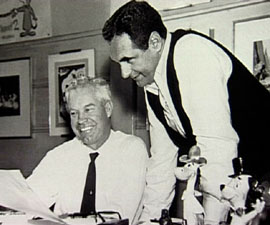
Making Television History
Previous TV animation had been included as part of puppet shows or new presentations of old theatrical material. Jay Ward’s 1949 Crusader Rabbit, for example, was on the air first; but this was only 5 minutes a day for four, and later five, days a week. Other early examples included The Gerald McBoing Boing Show, a UPA variety program starting in December, 1956; and stop-motion animated Gumby was spun off of The Howdy Doody Show in March, 1957.
Close to the end of their MGM days, the pair had secretly dabbled in television production by producing some animated promotional spots for I Love Lucy that were well received. Bill Hanna later got a jump on things after the MGM firing when he formed Shield Productions, Inc. with animator Mike Lah in order to produce a new batch of color Crusader Rabbit shows for Jay Ward using mainly former MGM staff. Three months of production later, it turned out that Ward might have no longer had rights to the characters after all. Shield dismantled and was folded into the new H-B Enterprises when Hanna re-partnered with Joe Barbera. George Sidney was its first president, and then Bill and Joe alternated in the role annually.
One big concern television executives had been the following: how could you expect to do a weekly show when most directors could only put out about one (short) cartoon a month? Joe and Bill figured it out, though— they developed a streamlined system that would later become known as “limited animation” where only parts of characters would need to be animated (like a mouth or one arm) at fewer frames per second than theatrical animation, and designs would be kept appealing but simple. Walk cycles and backgrounds could also be used repeatedly. Additionally, the backgrounds could be kept quite simple since anything else would not register on the small TV screens of the time anyway. (Alex Anderson, Jay Ward and their colleagues had found similar shortcuts for their earlier Crusader Rabbit, too.) Still, practically all the major networks and studios turned down Hanna and Barbera repeatedly.
Hanna-Barbera (the name order was decided by a coin toss) found its first interested party in Columbia Pictures’ television division, Screen Gems. To snag Columbia, they had to sell them on the idea that animation for television could be made cheaply and quickly. Yes, it would later lead to the public perception of animation being crudely done, and later to the belief that it was only for children, but at the time it was the only place for animation to go. If animation would not be seen on television, it would rarely be seen at all. Like it or not, the future of animation would lie in cheap television product.
Hanna-Barbera showed up at Screen Gems at the right time, as sales head John Mitchell had just been convincing studio chief Harry Cohn to re-package their theatrical cartoons for television, using newly animated bridging sequences. Mitchell contacted the renowned team of Hanna-Barbera, and they came to their meeting with a completed storyboard for a show called Ruff And Reddy. Fall of 1957 saw them getting commissioned for the first Ruff And Reddy trial segment, just months after being fired from MGM.
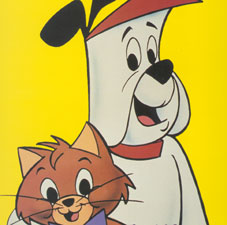
Cohn reacted unfavorably to the first test reel and told Mitchell to get rid of Hanna-Barbera and to drop the idea altogether. Fortunately, NBC was also shown the footage and was sold on the show. So, Hanna-Barbera was in business after all. They took over Charlie Chaplin’s old Highland Avenue studio and they got to work producing Ruff And Reddy segments… limited to a budget of $3,000 each, a tenth of what their theatrical cartoons had cost.
Of course, to survive on television, the new shows would need to be fresh and funny. Hanna-Barbera avoided the temptation to create another antagonistic duo like Tom and Jerry, instead making the dog Ruff and cat Reddy bosom pals. Their adventures would be somewhat outrageous, as they were shown battling sinister forces of evil. Hanna and Barbera both considered perfect voice casting to be absolutely essential to any cartoon’s success, so Ruff and Reddy were voiced respectively by Hanna-Barbera legends-to-be Don Messick and Daws Butler. Their serialized stories of six-minute episodes spanned at least ten segments each, mixed in with old Columbia cartoons (as Columbia decided not to finance an entirely new show). The Ruff And Reddy Show was hosted by a man-and-puppets team, starting in December, 1957. Original episodes were shown through the 1959-1960 season, and then repeats ran until 1964. Hanna-Barbera was clever enough to produce the show in color, even though it began its broadcast run being shown in black and white. (Color came to television in 1959.)
Despite the limited animation, Ruff And Reddy still had plenty of zing. The clever situations and precise timing that was evident in the “Tom And Jerry” cartoons was still there. H-B Enterprises had its first hit. Critics praised the show, NBC offered Hanna-Barbera a five-year contract to develop new shows, and they got to work. They were aided somewhat by the collapse of theatrical animation, which freed dozens of talented artists and storytellers. Their former colleagues from MGM were especially welcomed. John Mitchell continued to represent them for the duration of their Screen Gems association, and Joe took on the role of salesperson when pitching shows to the networks, sponsors, and distributors.
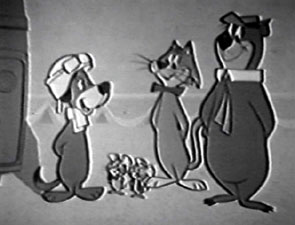
Hanna-Barbera was anxious to make an all-cartoon show, with no live-action hosts or other filler. Their first show in this mould would be The Huckleberry Hound Show, which relied on other new cartoons to fill out the program— so aside from Huckleberry, there was also Pixie And Dixie (and Mister Jinx), and Yogi Bear in their own segments. The show was created without a sponsor initially, but was quickly sold to Kellogg’s. Barbera recalled it being John Mitchell who handled the sale over the phone, which led to a long-term relationship between Kellogg’s and Hanna-Barbera and its agency, Leo Burnett. It was Joe, however, who would later have to give the pitch in person. The sales pitch did not start out well, as the wrong audio track was presented, resulting in Yogi’s voice coming out of Pixie’s mouth; but then the tracks were changed, and the ad chiefs found the show hilarious. The Huckleberry Hound Show debuted on October 2, 1958 courtesy of Screen Gems syndication, and it became a hit. It was not just seen as being for kids, either, as it was also popular on college campuses. A year later, the show won the first Emmy given to a cartoon show; and unlike the Oscars they had earned, Hanna and Barbera were able to accept the award as the show’s producers. Now, Hanna-Barbera was critically as well as commercially successful.
The next show to come to syndicated television was Quick Draw McGraw in 1959, starring a slow-talking horse and his sidekick Baba Louie, a Mexican burro, in the Old West. The bumbling but self-assured Quick Draw on occasion would change into Zorro-like “El Kabong”, Hanna-Barbera’s first “superhero” (well, sort of). The other segments in the show had cat and mouse detectives Snooper And Blabber, and the family antics of Augie Doggie And Doggie Daddy. (The show also was seen on CBS in 1963, as part of its Saturday morning line-up.)
At this time, the studio branched out into doing theatrical cartoons with a character named Loopy De Loop, a French-accented wolf who had difficulty convincing people of his well-meaning intentions. Almost fifty episodes were made from 1959 to 1965.
Yogi Bear and sidekick Boo Boo got their own show in 1960, again via Kellogg’s and Screen Gems (Sgt. Bilko-like con artist Hokey Wolf replaced Yogi on The Huckleberry Hound Show.) The hugely popular Yogi Bear Show also starred Snagglepuss the lion and a little duckling named Yakky Doodle. Yogi’s popularity increased throughout the 1960’s, leading to him starring in Hanna-Barbera’s first feature film, Hey There, It’s Yogi Bear, in 1964.
Whatever your opinion of the limited animation seen in these early H-B shows, one thing cannot be denied: They are darn funny! In fact, in terms of humor I would place Yogi, Quick Draw, and Huckleberry’s cartoons next to the best of Bugs and Daffy. This was aided not only by the skilled direction and guidance of the studio’s founding fathers, but also by the presence of such top writers as Michael Maltese, Warren Foster, and Charlie Shows; and the considerable voice talents of Daws Butler and Don Messick, who brought a tremendous appeal to the characters. The richness of the various characters is evidenced by the fact that a few of them were spun off into their own syndicated programs in the 1960’s.
Enter the Flagstones
By now, Hanna-Barbera had shows airing on Monday (Huckleberry Hound), Wednesday (Quick Draw), and Friday (Yogi). Being syndicated, they could be shown whenever the local station chose, but they tended to be shown in the early evening. All three shows were seen in well over a hundred markets, and all were performing well. The next step would be to enter prime time.
It was actually the idea of John Mitchell, who thought that Hanna-Barbera could successfully make a prime-time situation comedy that could be enjoyed by both kids and adults. It was an innovative idea, and a challenge that Bill and Joe looked forward to meeting. They also knew that they had to come up with something different than funny animals. Although their TV shows had been successful, they all had featured the types of antics seen on movie screens for decades. A move to prime time needed a fresh idea to justify it.
They came up with an idea of making a show similar to the beloved Honeymooners program that starred Jackie Gleason. Still, this obviously was not original in itself; they needed a special catch. They tried out some sketches of pilgrims, ancient Romans, and more contemporary figures until they hit upon the idea of a prehistoric family, aided by a drawing made by Dan Gordon (Joe’s old Terrytoons colleague). This is what would make their sitcom different— the situations might be the standard ones of many sitcoms, but the execution would include numerous prehistoric gags and plays on words. And so The Flagstones was born!
Only, that name was already taken, by the characters in the Hi And Lois comic strip, so the name was changed to The Flintstones. And the rest is Stone Age history.

It was not so easy to sell the show initially, though. It took all the efforts of Joe Barbera and John Mitchell, making the rounds with sponsors and networks, to find someone willing to take a chance on the novel idea. By all accounts, most people liked the idea and Joe’s spirited presentations, but the idea was so new that no one was sure that it could be successful. Finally, after being turned down by numerous sponsors, as well as NBC and CBS, ABC bought the show. Next, they found two sponsors in the Reynolds Tobacco Company (leading to commercials of Fred and Barney smoking cigarettes), and Miles Laboratories, makers of One-A-Day vitamins and the later Flintstones vitamins.
The Flintstones debuted on September 30, 1960, a historic occasion but not an auspicious one. Most critics disliked the show initially, but it still ended up receiving an Emmy nomination and Golden Globe Award in its first season. By the second season it was a recognized hit, and its prime time run would last 166 episodes before ending in 1966. As its original run ended, Hanna-Barbera featured Fred and the gang in the second H-B feature, The Man Called Flintstone, a James Bond/spy movie spoof that had Fred taking the place of a look-alike spy and going up against the Green Goose.
Moving right along, 1961 saw the debut of one of H-B’s most celebrated programs, as Top Cat began on ABC. It was a new type of program for H-B in that it featured anthropomorphic animals in an urban setting for half-hour stories. Street-smart Top Cat and his fellow city felines were continually involved in schemes to make their lives better, usually being thwarted by Officer Dibble. The 28 episodes are generally considered to be among the more sophisticated shows from H-B, due to the sly dialog and the ensemble cast.
Once The Flintstones was a certified hit, Hanna-Barbera used a similar formula but looked to the future for their series The Jetsons. This show debuted in prime time on ABC in 1962. The ratings were disappointing, largely due to it being scheduled against Walt Disney’s Wonderful World Of Color and Dennis The Menace. It only ran one season, but its 24 episodes were very popular on Saturday mornings the next year, and the show is still a favorite of H-B fans.
It was about this time that Hanna-Barbera left Screen Gems when Screen Gems tried to reduce H-B’s fees. Another important development occurred in 1963, when H-B built its own studio on Cahuenga Boulevard to accommodate the company’s expansion. By 1964, they had 400 employees.
More Funny Animals
Hanna-Barbera was far from abandoning funny animal shorts, however. In 1963, H-B created a syndicated show featuring a variety of new characters in The Hanna-Barbera New Cartoon Series. The characters created for this show went on to become well-known members of the H-B menagerie. These included Wally Gator, Lippy The Lion (& sidekick Hardy Har Har), and Touché Turtle (with Dum Dum).
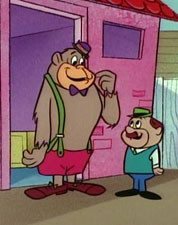
1964 saw two similar anthologies. The Magilla Gorilla Show was created in collaboration with Ideal Toys, and included segments with sheriff Ricochet Rabbit and a nondescript duo consisting of hillbilly cat and a mouse named Punkin Puss And Mush Mouse. Later in 1964, Peter Potamus And His Flying Balloon debuted in syndication with segments for Breezly And Sneezly (a polar bear and seal in Alaska), and the Three Musketeers spoof Yippee, Yappy And Yahooey. At one point, Magilla’s Punkin Puss And Mush Mouse switched spots with Peter’s Breezly And Sneezly. Peter’s show was re-titled for ABC in 1967, as The Peter Potamus Show, and again as The Magilla Gorilla/Peter Potamus Show for later syndication.
Hanna-Barbera Gets Adventurous and Superheroes Get Serious
Joe and Bill began to get the itch to create action-oriented shows. This would be another innovation, as up to that time American cartoons on TV had been exclusively humorous. First up was a 1964 ABC Friday evening program inspired by the Tom Swift books and the comic strip Terry And The Pirates.

The Adventures Of Jonny Quest turned out to be one of the all-time great Hanna-Barbera shows. Jonny was a boy who encountered dangers of a relatively realistic nature (with some science fiction elements) while globetrotting with his scientist father, an Indian boy, a bodyguard, and a puppy. This was a tremendous departure from all previous H-B shows, with non-cartoony human beings and environments (designed by comic book artist Doug Wildey) involved in stories that included real danger. Jonny came out a year after the Astro Boy import series from Japan, and helped to pave the way for acceptance of more action-adventure American cartoon shows such as 1966’s Filmation series The New Adventures Of Superman.
Perhaps inspired by the Saturday morning success of The Mighty Mouse Playhouse (1955-1966), H-B had superhero animals take to the forefront in 1965’s series The Atom Ant/Secret Squirrel Show (there was also a special one-hour preview called The World Of Secret Squirrel And Atom Ant). Respectively, the segments had a super-strong insect, and a super-spy rodent. The stories may have featured crime lords and mad scientists as adversaries, but the tone was still humorous. This hour-long show was padded by segments featuring Precious Pup and The Hillbilly Bears (with the Atom Ant half-hour), and Squiddly Diddly and Winsome Witch (with Secret Squirrel). Meanwhile, The Adventures Of Sinbad, Jr. entered syndication.
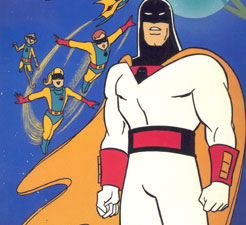
The next step towards creating human caped action heroes came when CBS head of daytime programming Fred Silverman decided to initiate a new era of TV superheroes in 1966. Aside from Filmation’s The New Adventures Of Superman series, Silverman scheduled Hanna-Barbera’s Space Ghost And Dino Boy. Back then, Space Ghost was a serious space hero (designed by comic artist supreme Alex Toth, who later designed many of the other H-B “super characters”) and not the wacky talk show host he would become decades later. Scripts were often by Ken Spears and Joe Ruby, who went on to work on many of the H-B superhero shows and later formed their own animation studio. Although drawing more realistic characters proved a challenge to the animation staff, there was actually less animation needed since flying characters only needed to have the backgrounds moved.
A more comic H-B series debuted at the same time also on CBS, Frankenstein Junior And The Impossibles. This show had separate segments featuring a gigantic masked robot and superheroes who formed a rock and roll band in their secret identities. Meanwhile, H-B was also starting a series on NBC aimed at a younger audience: the less-remembered Space Kidettes. 1966’s other H-B series was their first to be based on real people, the syndicated Laurel And Hardy. Abbott And Costello followed in 1967.
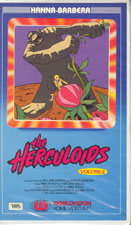
Space Ghost And Dino Boy was a smash hit, so H-B got the opportunity to produce three more adventure shows for CBS in the 1967 season. The Herculoids featured heroic adventure on a distant world, and involved grotesque-looking creatures as well as humans. Shazzan was a 60-foot genie who transported a boy and girl to ancient Arabia. Moby Dick And The Mighty Mightor included segments with a friendly whale and a stone age boy who used a magical club to turn into a superhero.
Amazingly, Hanna-Barbera had three more adventure shows on other networks that same year (1967), as the superhero bandwagon was officially rolling. ABC had the Marvel Comics-inspired Fantastic Four, and NBC ran both Samson And Goliath (a boy and dog turn into super-strongman and lion) and the less obscure Birdman And The Galaxy Trio.
Bill and Joe had their time freed up slightly when they sold their studio to Taft Broadcasting in 1967.
The last hurrah for the Saturday morning 1960’s superhero cycle came in 1968 with The Adventures Of Gulliver on ABC, and NBC’s Banana Splits Adventure Hour, which had live actors in animal suits hosting the cartoon segments Arabian Knights, The Three Musketeers, Hillbilly Bears, and The Micro Venture. At this time, there was pressure from activist groups to reduce violence in children’s programming; and, more importantly, ratings for such shows were sinking. A new type of show was needed to raise ratings and restore Hanna-Barbera’s luster— one that would combine humor and adventure. Once again, Bill and Joe (and their creative staff) would create a show perfect for what audiences were ready for.
Scooby Does It
Violence was on the way out, but there could still be action. 1968 saw the premiere of Wacky Races, a zany show with numerous offbeat characters competing each week in a race. The show and its characters were so popular that Silverman encouraged Hanna-Barbera to develop spin-offs for the 1969 season, resulting in Dastardly And Muttley In Their Flying Machines (set in World War II, where they chased a carrier pigeon), and The Perils Of Penelope Pitstop (here an heiress evading the Hooded Claw with her Wacky Races helpers, The Ant Hill Mob).
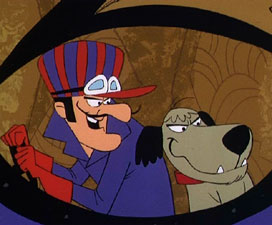
But of course the biggest star to emerge in the 1969 post-superhero boom was Scooby Doo, in the CBS series Scooby-Doo, Where Are You?, which ran after Penelope. This was to be H-B’s crowning example of comedic adventure, starring a cowardly Great Dane and four teenagers solving mysteries of paranormal phenomena. Oddly, the dog was not originally to be the star of the show, until Silverman was asked by the network to tone down the horrific elements in the show as developed by Ruby and Spears. The decision was made to bring the dog character to the forefront, and the show became a television classic, thanks largely to the landmark design work by Iwao Takamoto. It also led to numerous imitators, especially from Hanna-Barbera itself.
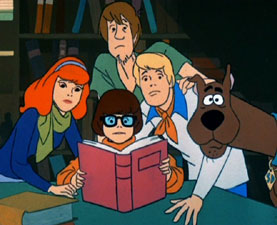
1969 also saw H-B doing three shows for ABC, all of which are probably less well known today than their CBS counterparts. These were grouped under the title The Cattanooga Cats, with musical feline characters hosting cartoon segments that also included Around The World In 79 Days, It’s A Wolf, and Autocat And Motormouse.
By this time, most of Hanna-Barbera’s big hits had been aired. There would be a few surprising successes in the future, but the 70’s and 80’s would include more than their share of misfires. Still, there was no doubt that Hanna-Barbera was still going to be at the top of the heap.
Next: The third and final part of this article— as spin-offs galore, goofy superheroes, a few neat shows, and a bunch of little blue people round out our look at the television years of Joe and Bill.


